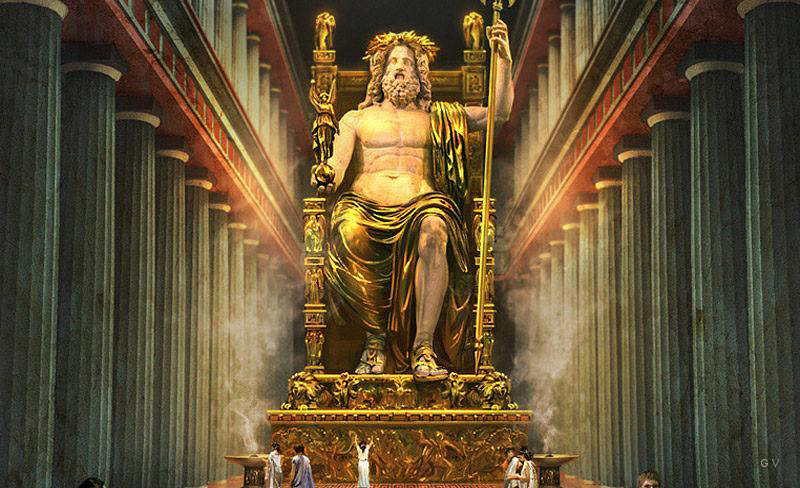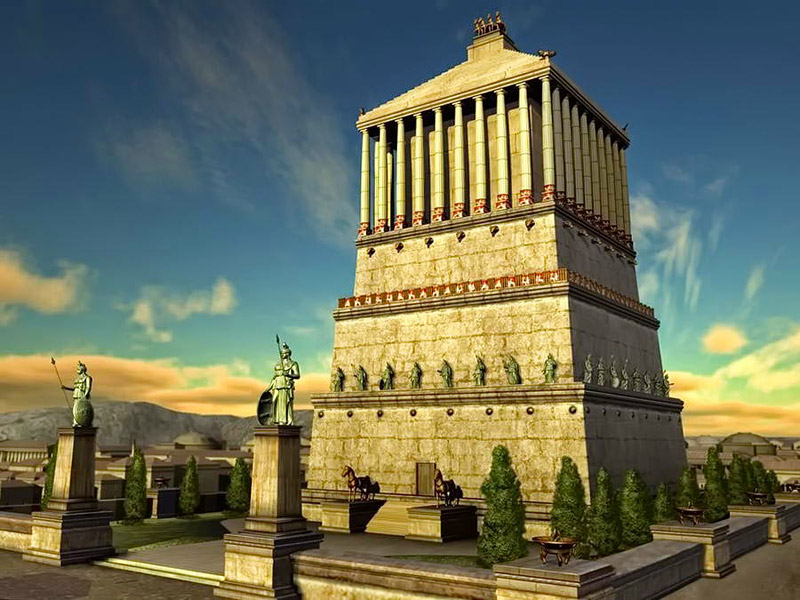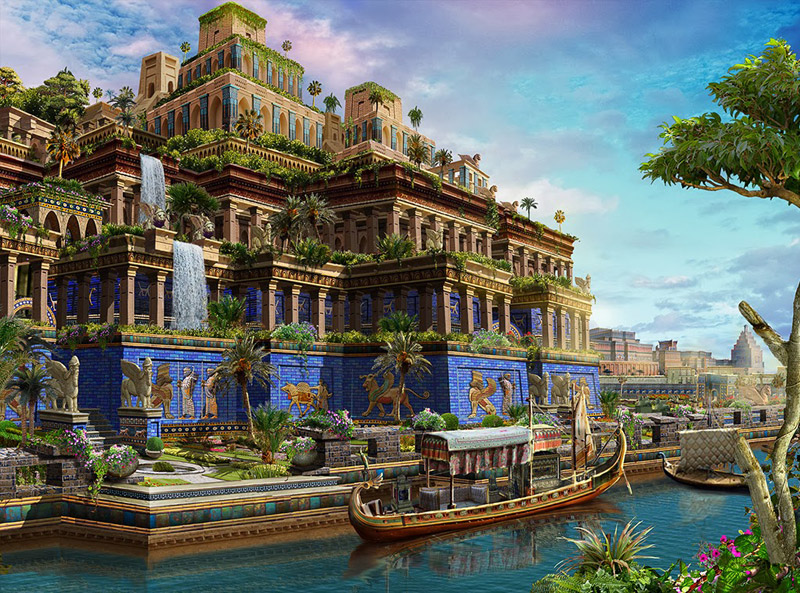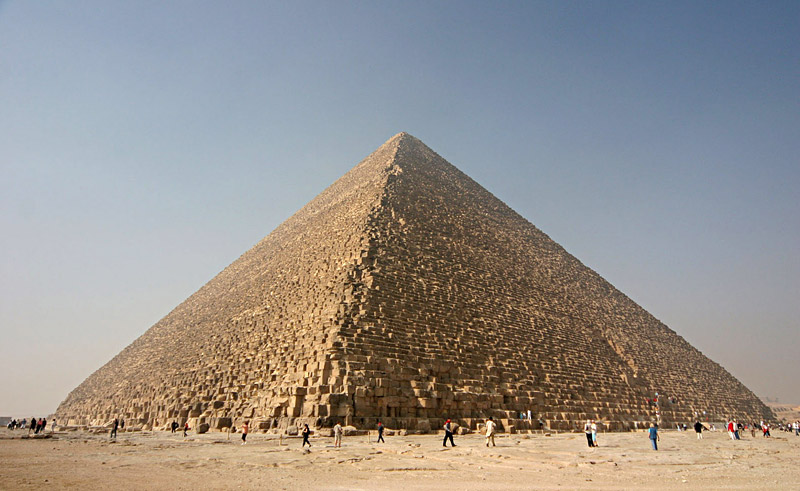
The ancient Greeks loved to compile lists of the marvelous structures in their world. Though we think of the Seven Wonders of the Ancient World as a single list today, there were actually a number of lists compiled by different Greek writers. Antipater of Sidon, and Philon of Byzantium, drew up two of the most well-known lists.
Why seven? The Greeks thought that the number had mystical significance. Perhaps because it was the total of the known planets (Mercury, Venus, Mars, Jupiter, Saturn) along with the Sun and Moon.
Many of the lists agreed on six of the seven items. The final place on some lists was awarded to the Walls of the City of Babylon. On others, the Palace of Cyrus, king of Persia took the seventh position. Finally, toward the 6th century A.D., the final item became theLighthouse at Alexandria.
Since the it was Greeks who made the lists it is not unusal that many of the items on them were examples of Greek culture. The writers might have listed the Stonehenge if they’d seen it, but this placs was beyond the limits of their world.
It is a surprise to most people to learn that not all the Seven Wonders existed at the same time. Even if you lived in ancient times you would have still needed a time machine to see all seven. While the Great Pyramid of Egypt was built centuries before the rest and is still around today (it is the only “wonder” still intact) most of the others only survived a few hundred years or less. The Colossus of Rhodes stood only a little more than half a century before an earthquake toppled it.
THE SEVEN WONDERS OF THE ANCIENT WORLD
The Statue of Zeus

This colossal statue represented the Greek god of heaven: Zeus. It was ordered in 450 BC. to the Athenian sculptor Phidias by the inhabitants of Olympia who wished to decorate the temple of the old town.
This statue was located on the west coast of Greece at Olympia. In the antiquity, this city was a place of cult which contained numerous treasures of the Greek art: temples, monuments, altars, theaters, statues and marble or bronze votive offerings. It was realized with golden and ivory, measured 12 m (39 feet) height and was placed on a base of 2 m (7 feet). The base of the statue was 6 m (21 feet) wide and 1 m height. The statue’s perimeter was 13 m (43 feet). This work touched almost the ceiling of the temple. On the other hand, the throne was decorated with precious stones, ivory, ebony and gold.
Zeus, in sat position, holds, in its right hand, the goddess of Victory, Nike, and, in the left hand, a scepter surmounted by an eagle. The throne was decorated with relief sculptured mythological scenes, notably evoking the murder of the sons of Niobe, the queen of Thebes.
Why is that a ancient wonder?
First of all, this work remained the statue of the god in honour of whom the ancient Olympic Games were created. They took place every four years and were the most famous ancient four games during which the Greeks were involved. The three others were the Isthmian games (at Corinth), the Pythian games (at Delphi) and the Nemean games (at Nemea). Then, we can say that with its greatness and its priceless value, the statue of Zeus distanced itself from the other Greek works. We can add that this is the biggest statue that the Greeks have ever realized.
Unfortunately, it was destroyed during the fire which ravaged the temple in 462. Nowadays, only stony ruins which were used for the construction of the temple remain.
The Colossus of Rhodes

This bronze statue representing Helios, greek sun god, had been built by the sculptor Charas of Lindos to commemorate the end of the seat of the city, which took place into 305 BC, and the victory of Rhodiens against the Macedonian chief Démétrios Poliorcète.
The colossus of Rhodes was located in the wearing of Rhodes in Greece, probably at the end of the current Saint-Nicolas Day mole, where some marble blocks have been found and could have been used to build the base of the statue.The colossus of Rhodes was set up between 303 and 291 BC, so it took twelve years of hard work to totaly finish it.
Made of bronze and based on marble block, the statue was 32 meters (105 feet) heigh from the top of the head to the feets, that is to say 14 meters (46 feet) less than the statue of liberty in New York. The heigh enabled the statue to be visible by the ships approching to the port. In his raised arm, the sun god held a torch while his other arm was pressed on a lance. Contrary to the illustrations we usually find, ships were not passing under the colossesus’s legs to enter in the wearing of Rhodes. It was technically impossible that the statue had its legs split.
The statue had been partialy destroyed in 225 BC after a earthquake. Then, in 653 AC, all the material (more than 13 tons of bronze and nearly 7 tons of iron, according to Philon) is taken by an arab expedition to be sold to a jewish merchant of Ephesea. The statue has been raised at the entry of the port for only 65 years
Why is this a wonder of the ancient world ?
We can say that the colossus of Rhodes is part of the seven wonders because of its exemplary vastness. Moreover, it should well be realized that this Greek monument is the result of a very hudge technical prowess which is characterized, amongst other things, by the use of terra cotta moulds necessary to the casting of the colossus. According to the legend, Charas of Lindos commited a suicide when he discovered an error in his calculs, error that one of his assistants had to correct.
The Mausoleum at Halicarnassus

It is a monumental grave located in the southwest of Turkey in the city of Halicarnassus (nowadays Bodrum) where lived the king of Carie named Mausole. He was also satrap1 of the king of Persia, to whom the Carie belonged.
It is very likely that Artemis, sister and woman of the satrap of Carie began the construction of this edifice in 353 BC, three years after the death of king, to honour him. The mausoleum was ended one year after the death of this woman.
With a total height of around 43 m (141 feet), it was sustained with thirty six columns and surmounted by a pyramid decorated of one quadriga2 with marble. The funeral chamber doubtless contained the graves of Mausole and Artemis. We could also observe a valuable frieze represented a fight of the Greeks against the Amazon and the Centaurs.
This monument was partly destroyed, by an earthquake, at around fourteenth century. A short time later, the knights of Malta decided to build a fortress: they used the stones of the mausoleum and in 1522, no one remained. Nowadays, we can again observe this fortress in Bodrum.
Why is this a wonder of the ancient world ?
This mausoleum was classified as a wonder because it distances itself by its beauty and its great value. Indeed, the ornaments of the sanctuary were realized by the most famous artists of its era: Satyrus and Pythius for the architecture; Scopas, Timotheos, Bryaxis and Leochares for the sculpture. The decorations and the sculptures were really magnificent. Several pieces were recover and can be seen in the British Museum of London.
The Lighthouse of Alexandria

The lighthouse was localized, between 1994 and 1996, in the port of Alexandria by the French archaeologist Jean-Yves Empereur. This is one of the most known ancient monuments and also most often represented because it was one of the first lighthouses. Indeed, we even found souvenir objects with reproductions of the image of the lighthouse in Afghanistan.
The Lighthouse is located in Egypt on the island of Pharaos (which gave the french word «phare ») in front of the city of Alexandria. During the centuries, this island was connected with the continent by the alluviums of the Nile, on which we built a road and a bridge. The lighthouse, built on the island, was begun under Ptolemy II Philadelphus and ended around 280 BC by Sostratus of Cnidus.
The lighthouse counted three floors: the first one was squared, the second was octagonal and the third cylindrical. The white marble whole measured approximately 135 m (440 feet) height from where we could see ships located 100 miles far away. Angles were decorated with bronze tritons which was used either to warn of the approach of the enemy by terrifying sounds, but also to carry mirrors which, durung the night, reflected the light of a fire. In the daytime, the smoke indicated to the boats the entrance of the port.
Why is this a wonder of the ancient world ?
Its important height and its exemplary robustness made the lighthouse of Alexandria unique. Indeed it was exposed to a strong wind coming from the sea, that is why it should be inevitably resistant enought. This edifice is the symbol of the technical exploit shown by the Egyptians. Furthermore it was one of the first lighthouses.
The Temple of Artemis

The Temple of Artemis at Ephesus served as well as a market place and a cult place for the goddess Artemis which was the divinity of the fertility, the Earth, the moon and the animals. She was very worshipped.
It was located in Turkey, in the ancient city of Ephesus which is nowadays called Selcuk, and which is located 50 km in the South of Izmir. This temple was set up from the middle of the eighth century to the middle of the third century BC It has the peculiarity to have been demolished seven times in ten centuries.
The first temple was primitive (8 columns on 4), however king Croesus ordered to destroy it in order to raise a new much larger one. With a base of 155 m (508 feet) on 60 (197 feet), the new sanctuary possessed 127 columns with sculptured reliefs. But it was destroyed again to leave place to the new temple drawn by the Greek architect called Chersiphron, even more gigantic than the precedent: its Ionic columns, adorned with gold, raised at more than 18 m height and contained scenes with mythological symbols sculptured by the lost famous sculptors and the Greek architects such as Scopas, Praxiteles, Phidias and Polyclitus. This last sanctuary sheltered the statues of Artemis and Zeus where these gods were worshipped by the Greek population. Nowadays, we can find some reproductions of the statue of this goddess in the museums of Naples, the Vatican and the Louvre.
Finally, during the night of 21st of July in 356 BC, a person called Herostratus set on fire the temple so that its name is immortalized. It is done. Stones were doubtless reused to build churches.
Why is this a wonder of the ancient world ?
Ephesus was famous in the Antiquity for its cult for Artémis in a temple whose magnificence permit to made it classified among the seven wonders of the ancient world. This temple was besides, one of the most Panhellenic crowned sanctuaries.
The Hanging Gardens of Babylon

The hanging gardens of Babylon are a quite mysterious wonder. Indeed, no Babylonian text describing them have been found. We don’t even know the destruction date of this wonder. Maybe this is just a product of Greeks imagination ?
The gardens were located on east the bank of the river Euphrates, in the city of Babylon (50 km from Bagdad) and may have been built in 600 bc. No Greek historian have seen them, it just consists in stories told by soldats, which is a quite doubtful source of informations.
According to the legend king Nebuchadnezzar II (604-562 BC) would have made build the famous hanging gardens of Babylon for his wife Sémiramis to remind her the vegetation of the moutains from her natal country : Media (actual Iran).
These gardens were composed of several floors, each was a terrace of 120 m² supported by vaults and pillars of brick. An immense staircase, made of marble, connected the terraces, where water was brought from the river Euphrates by a system of hydraulic screws. It was a real botanical garden where was cultivated plants and trees of Mesopotamia and of Media. On the first eight meters height terrace were planted big trees : plane trees, palm trees – date palms, pines and cedars. On the second thirteen meters height terrace were located the cypresses and quantity of fruit trees. And even heigher, on the two last terraces, less vast than the others, we could find the anemones and the tulips, the lilies and the irises… without forgetting the roses, so appreciated from the beautiful Sémiramis.
Why is this a wonder of the ancient world ?
At the time, it was an innovation : for the first time Greeks saw hanging gardens on the roofs. Moreover, the meeting of all this diversity of plants was to be splendid and should have amply satisfy Sémiramis.
The Great Pyramid of Giza

Near the Cairo city, in Egypt, is raised the most ancient and the only survivor of seven wonders of ancient world: the Great Pyramid of Giza also called Pyramid of Khufu located near to two other smaller pyramids: Khadre and Menkaure.
We consider that the Pyramid of Khufu was built near 2800 BC but the uncertainty concerning this date remains important. This pyramid would have been drawn by Imhotep, Egyptian architect of the third dynasty of ancient Egypt.
The Egyptians reached the perfection by building this edifice that was raised by the Pharaoh Khufu and that we know nowadys with the name of the Great Pyramid of Giza. Indeed, he wished for himself a grave able to endure the time. A gigantic, inviolable grave which would preserve its divine slough for the eternity… This pyramid is exceptional looking at its dimensions: 232 m (761 feet) wide and 146 m (480 feet) height, and its internal arrangements: not less than three chambers, among two ones directly built in the stone block. To reach the king’s room, a long gallery of 47 m (154 feet) and 8.50 m (28 feet) height was imagined. To proceed to the construction of its monumental ambition, Khufu even order to bring stones extracted from the mountains of Arabia which were loaded on boats to go down the Nile until Gizeh.
This set of pyramids were raised by thousands of persons chosen among the Egyptian population. By these constructions, they proved their power that we can even recognize nowadays by observing these pyramids in Gizeh.
Why is this a wonder of the ancient world ?
The Pyramid of Khufu is the extraordinary testimony of the human genius because it was immense and impressive considering the epoch. Even nowadays, it remains one of the biggest human constructions.




Leave a Reply